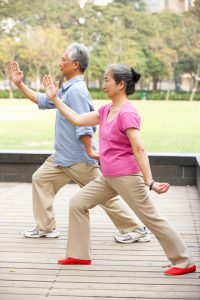Improve the Health of the Elderly with Depression with Tai Chi
By John M. de Castro, Ph.D.
“adding a mind-body exercise like tai chi that is widely available in the community can improve the outcomes of treating depression in older adults.” – UCLA Health
The aging process involves a systematic progressive decline in every system in the body, the cardiovascular system and respiratory system included. The elderly frequently also have problems with attention, thinking, and memory abilities, known as mild cognitive impairment. An encouraging new development is that mindfulness practices such as meditation training and mindful movement practices can significantly reduce these declines.
Tai Chi has been practiced for thousands of years with benefits for health and longevity. Tai Chi training is designed to enhance function and regulate the activities of the body through regulated breathing, mindful concentration, and gentle movements. Tai Chi practice has been found to be effective for an array of physical and psychological issues. Tai Chi has been shown to help the elderly improve attention, balance, reducing falls, arthritis, cognitive function, memory, and reduce age related deterioration of the brain. The elderly are often depressed. So, it makes sense to study the effectiveness of Tai Chi practice on the health of the elderly with depression.
In today’s Research News article “Comparison of the effects of Tai Chi and general aerobic exercise on weight, blood pressure and glycemic control among older persons with depressive symptoms: a randomized trial.” (See summary below or view the full text of the study at: https://www.ncbi.nlm.nih.gov/pmc/articles/PMC9077840/ ) Wang and colleagues recruited older adults (> 60 years of age) who had depressive symptoms and randomly assigned the to receive 3 times per week for 60 minutes for 12 weeks of either Tai Chi practice or 20 movement low impact aerobic exercise. They were measured before and after training and 3 month later for body size, blood pressure and blood HbA1c levels.
They found that in comparison to baseline and the aerobic exercise group, the group that practiced Tai Chi lost a significantly greater amount of weight and Body Mass Index (BMI), had significantly lower systolic and diastolic blood pressure, and had significantly lower HbA1c levels. Hence, in older adults with depressive symptoms Tai Chi practice is more effective than aerobic exercise in reducing body weight, blood pressure, and improving long-term glucose control.
So, Tai Chi improves the physical well-being of older adults.
“tai chi is an exercise form you can practice all your life. Good for the mind and the body, it’s a physical activity that will help keep you feeling healthy for years to come. “ – NHSNetworks
CMCS – Center for Mindfulness and Contemplative Studies
This and other Contemplative Studies posts are also available on Twitter @MindfulResearch
Study Summary
Wang, Y., Luo, B., Wu, X., Li, X., & Liao, S. (2022). Comparison of the effects of Tai Chi and general aerobic exercise on weight, blood pressure and glycemic control among older persons with depressive symptoms: a randomized trial. BMC geriatrics, 22(1), 401. https://doi.org/10.1186/s12877-022-03084-6
Abstract
Background
Blood pressure and glycemic control are associated with the management of depressive symptoms in patients with depression. Previous studies have demonstrated that both Tai Chi and aerobic exercise have positive effects on blood pressure and glycemic control. Few studies have compared the physiological effects of Tai Chi versus aerobic exercise in older adults with depressive symptoms. The objective of this study was to compare the effects of Tai Chi and aerobic exercise on weight, body mass index, blood pressure and glycosylated hemoglobin (HbA1c) level in older persons with mild to moderate-severe depressive symptoms.
Methods
A randomized controlled trial was performed. The older persons (age ≥ 60 years old) with depressive symptoms were recruited. Then, participants were randomly allocated to the Tai Chi group and the aerobic exercise group received a 12-week 24-movement Yang’s Tai Chi intervention and aerobic exercise, respectively. Data collection occurred at baseline and after completion of the interventions (week 12).
Results
A total of 238 participants with mild to moderate-to-severe depressive symptoms were included in the final analysis, including 120 in the Tai Chi group and 118 in the aerobic exercise group. The difference in weight and body mass index in the Tai Chi group was 2.0 kg (Z = -4.930, P < 0.001) and 0.77 kg/m2 (Z = -5.046, P < 0.001) higher than that in the aerobic exercise group, respectively. After the 12-week intervention, the systolic pressure and diastolic pressure in the Tai Chi group were 5.50 mmHg (Z = -2.282, P = 0.022) and 8.0 mmHg (Z = -3.360, P = 0.001) lower than that in the aerobic exercise group, respectively. The difference in HbA1c level in the Tai Chi group was 0.50% higher than that in the aerobic exercise group (Z = -4.446, P < 0.001).
Conclusion
This study showed that Tai Chi exercise was more effective in improving blood pressure and HbA1c level than general aerobic exercise. It suggested that Tai Chi might be an effective approach for the management of blood pressure and long-term glucose control in older persons with depressive symptoms.
